Friday March 9
Lake Titicaca is at 12,507 feet altitude and the highest navigable lake in the world.
The Uru or Uros (Uru: Qhas Qut suñi) are an indigenous people of Peru and Bolivia. They live on 92 self-fashioned floating islands in Lake Titicaca near Puno. They form three main groups: Uru-Chipayas, Uru-Muratos and the Uru-Iruitos. The latter are still located on the Bolivian side of Lake Titicaca and Desaguadero River.
The Uru use bundles of dried totora reeds to make reed boats (balsas), and to make the islands themselves.
The larger islands house about ten families, while smaller ones, only about thirty meters wide, house only two or three families.
The islets are made of totora reeds, which grow in the lake. The dense roots that the plants develop and interweave form a natural layer called Khili (about one to two meters thick) that support the islands. They are anchored with ropes attached to sticks driven into the bottom of the lake. The reeds at the bottoms of the islands rot away fairly quickly, so new reeds are added to the top constantly, about every three months; this is what makes it exciting for tourists when walking on the island. This is especially important in the rainy season when the reeds rot much faster. The islands last about thirty years.
Each step on an island sinks about 2-4" depending on the density of the ground underfoot. As the reeds dry, they break up more and more as they are walked upon. As the reed breaks up and moisture gets to it, it rots, and a new layer has to be added to it. It is a lot of work to maintain the islands. Because the people living there receive so many tourists now, they have less time to maintain everything, so they have to work even harder in order to keep up with the tourists and with the maintenance of their island. Tourism provides financial opportunities for the natives, while simultaneously challenging their traditional lifestyle.
Food is cooked with fires placed on piles of stones. To relieve themselves, tiny 'outhouse' islands are near the main islands. The ground root absorbs the waste. They now use chemical toilets as in the past they just used the lake and of course that was poluting the lake.
early morning view of Lake Titicaca - view from hotel
one of the numerous Guinea Pigs on the grounds
Puno Teal
Chiguanco Thrush
Slate-colored Coot
in the boat
approaching the islands
the family on the island we are visiting greets us
We got off our boat onto one of the islands and it was awesome walking on the floating reeds. We were shown how they build the islands and divide them when they want to make a new island. The number of islands changes frequently as families grow and they spli the island or consolidate and island to make a bigger one. We saw where the children go to school. We were invited to see inside their homes made of reeds. Of course there was shopping. They sell many items they sew or make from reeds.
she laid blankets on the "couch"
The Chief
the group
one of the reeds they make everything out of - you can eat the white part & I tasted it
he demonstrates how they divide the islands with this saw
the Chief demonstrated how they build the reed mats to make the islands
they performed for us
we were invited to visit inside one of the homes
the guy taking the photos liked to hold it low and shoot up
of course they set up a market
closeup of the reed floor
Yellow-winged Blackbird
the family waving good-bye to us
The Chief & his wife rowed the reed boat
2 of the kids sang for us on the boat ride
 |
We toured one more island that has a "motel" on it. (about $25 a night) No heat and it's just a reed house like they live in.
the motel room
inside
Back on our speedboat we take a few more final shots of the area
pushing a reed boat back to one of the islands
White-tufted Grebe
We had a 40 minute hike from one side of Taquille Island to the other walking uphill at that altitude was not for the feint of heart. It was absolutely beautiful with sheep, cows, farm lands and the indigenous people going about their daily lives. They are known for their weaving and knitting. We were welcomed by a group and we were taught how to greet them and we greeted each one of them as we shook their hands going down the line. Then, we were seated and they showed us how they made shampoo and washed wool. The men knit and the women weave and they showed us how they did that. Then, they sang and danced for us and invited us to dance with them. One of the young girls picked me.
We saw people milking cows, herding sheep and the countryside was gorgeous. Due to the sunny day, we all were taking off a few layers of clothing as we walked.
on the island
we walked up from the bottom to start the hike
Cream-winged Cinclodes
Andean Lapwing (bad photo, but it's the only one we got)
terraced gardens
it does look like a face
knitting while he walks
cemetery
Peruvian-Sierra Finch
young boys knitting
they greeted each of us
making soap
our walk to the restaurant to the other side of the island
they grow many varieties of quinoa
check out the horns....
Sparkling Violetear
the path down to the restaurant
We started with a Quinoa soup that was very good. Then they brought out various dishes that included cold vegetables, chicken, fish, quinoa croquets, rice, sweet potatoes and white potatoes. All of it was very tasty. For desert they made black quinoa pancakes with berry and honey syrup. They tasted like chocolate. Surprisingly good!
Yellow-billed Teal
the reataurant
boarding the boat
Titicaca Grebe
Then, it was time to reboard the boat and go back to the hotel. We all pretty much just napped all the way back. These tours are always my favorites, I just love the local color. Peru in general is a favorite country of mine. Their family colors are amazing. Each family has their own style of dress, colors, hats, belts etc.
As we were getting off the boat we noticed a party going on next to the hotel and our guide said they were doing a tree cutting ceremony. They do it once a year and whoever is the one to take the final blow that fells the tree gets to plan the next years party. Greg and I watched them for a long time as they circle the tree singing and dancing. They were all in native dress and they were drinking and spraying fake snow at each other. They would pour alcohol on the tree and on the axe and everyone took turns chopping at the tree and then dancing and passing the axe to the next person. (men and women alike). Finally, it came down and they ascended upon the tree trying to get the items that were hung in the tree. Interesting to watch! They were still partying until a thunder storm stopped their outdoor fun.
back at the hotel
tree cutting ceremony
there it goes...
they ascended on the tree to grab the trinkets in it
the hotel
hotel lobby
fried guinea pig - Cuy
Peruvian Sierra Finch
the rain had cleared and they resumed the party
walking to the restaurant
pisco sours
sign we saw on the walk back to the car
****to give you an idea of how much we save doing private excursions, for the Nazca Lines trip Princess charged $750.00 per person. Private tours were $190 to $250 per person. Of course there isn't always that much savings, but even if it were the same price the big bus tours of up to 45 people are just not fun to deal with. Yes, there can be problems with private tours, but you can experience that on Princess as well. (or whatever cruise line you use)
Up bright and early tomorrow for our transport to the airport and our flight back to Lima.
from the plane window
Taquile Island Lake Titicaca Puno, Ecuador https://photos.app.goo.gl/4KCVHbmnq6DHNQ8T2
Floating of Uros Lake Titicaca Puno, Ecuador https://photos.app.goo.gl/STzBuBMRGFP0cjXu1
Puno, Peru Tree cutting & culture show https://photos.app.goo.gl/MIM0He0Wa5R4k2q22
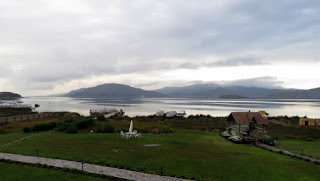
















































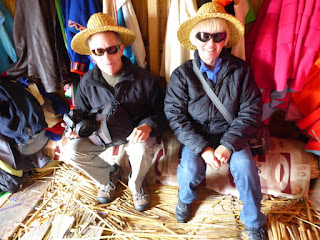



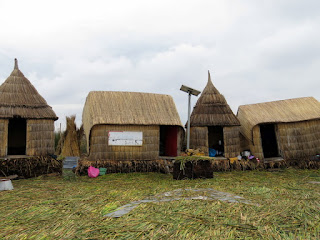













































































































































































































































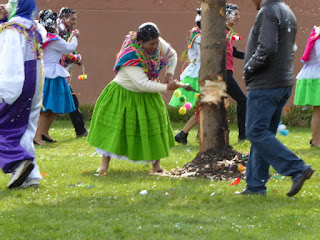












































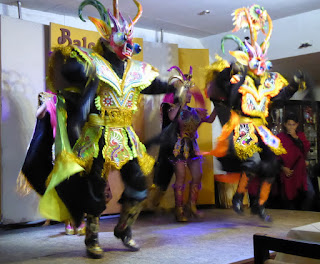














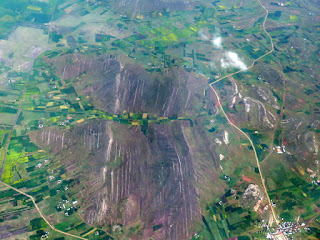

No comments:
Post a Comment